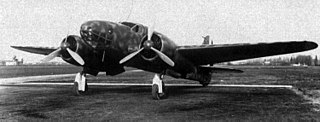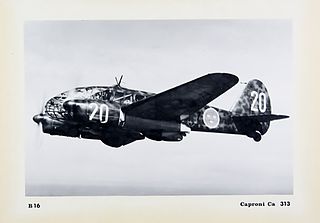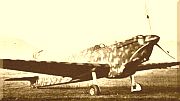| Ca.311 | |
|---|---|
 | |
| Role | Reconnaissance bomber |
| Manufacturer | Caproni |
| First flight | 1 April 1939 |
| Primary user | Regia Aeronautica |
| Number built | 335 |
The Caproni Ca.311 was a light bomber-reconnaissance aircraft produced in Italy prior to and during World War II.
| Ca.311 | |
|---|---|
 | |
| Role | Reconnaissance bomber |
| Manufacturer | Caproni |
| First flight | 1 April 1939 |
| Primary user | Regia Aeronautica |
| Number built | 335 |
The Caproni Ca.311 was a light bomber-reconnaissance aircraft produced in Italy prior to and during World War II.
The Ca.311 was a member of the large family of Caproni designs derived from the Ca.306 airliner prototype of 1935, and more directly a modification of the Ca.310 bomber. As with other related types, it was a low-wing cantilever monoplane of conventional design. This particular design incorporated the Ca.310's retractable main undercarriage, as well as the heavily glazed nose that had been tested on the Ca.310bis prototype. New features included a relocation of the dorsal turret to a position immediately aft of the cockpit, and additional glazing throughout the fuselage.
From 1940, this aircraft began to replace the IMAM Ro.37 in service, completing this process the following year.

General characteristics
Performance
Armament

The CANT Z.1007 Alcione (Kingfisher) was an Italian three-engined medium bomber, with wooden structure. It was designed by Filippo Zappata, who also designed the CANT Z.506 and had "excellent flying characteristics and good stability". It was regarded by some as "the best Italian bomber of World War II" although its wooden structure was easily damaged by the climate, as experienced in North Africa and in Russia. It was used by the Italian Regia Aeronautica, Italian Co-Belligerent Air Force, Aeronautica Nazionale Repubblicana and Luftwaffe during World War II.

The Breda Ba.65 was an Italian all-metal single-engine, low-wing monoplane that was used by Aviazione Legionaria during the Spanish Civil War and Regia Aeronautica in the first half of World War II. It was the only Italian ground-attack aircraft that saw active service in this role. It saw service almost exclusively in the North African and Middle-Eastern theatre. In addition to more than 150 aircraft operated by the Italian forces, a total of 55 were exported and used by the air forces of Iraq, Chile and Portugal.

The Caproni Ca.133 was a three-engined transport/bomber aircraft used by the Italian Regia Aeronautica from the Second Italo-Abyssinian War until World War II.

The Fiat CR.25 was an Italian twin-engine reconnaissance-fighter aircraft which served in small numbers for the Regia Aeronautica during World War II.

The Breda Ba.64 was an Italian single-engine ground-attack aircraft used by the Regia Aeronautica during the 1930s.

The Caproni Ca.314 was an Italian twin-engine attack/torpedo bomber aircraft, used in World War II.

The Caproni Ca.310 Libeccio was an Italian monoplane, twin-engine reconnaissance aircraft used in World War II. Derived from the similar Ca.309, it had its combat debut during the Spanish Civil War and took part in the earlier phases of World War II in Libya. Some were used in attack groups as a temporary replacement for the unsatisfactory Breda Ba.65. The last Ca.310 was retired by the Italian Air Force in 1948.

The Caproni Ca.309 Ghibli was an Italian aircraft used in Libya and North Africa from 1937 to 1943. Its nickname, 'Ghibli', refers to a Libyan desert wind.

The Caproni Ca.111 was a long-range reconnaissance aircraft and light bomber produced in Italy during the 1930s. It was a derivative of the Ca.101.

The Breda Ba.201 was an Italian dive bomber designed during World War II, that never entered production.

The Caproni Ca.313 was an Italian twin-engine reconnaissance bomber of the late-1930s. It was a development of the Ca.310. Its variants were exported to several other countries.
The Piaggio P.32 was an Italian medium bomber of the late 1930s, produced by Piaggio, and designed by Giovanni Pegna. It was a modern design for its time, but was a failure due to lack of powerplants commensurate with its high wing loading.

The Caproni Ca.132 was a prototype for a large aircraft built in Italy in 1934, intended for use as either a bomber or airliner. It was a conventional low-wing cantilever monoplane, powered by a radial engine on each wing and in the nose. The main undercarriage was housed within large streamlined spats. Configured as an airliner, it would have seated 20 passengers.

The Caproni Ca.316 was a reconnaissance seaplane produced in Italy during World War II, intended for catapult operations from Italian Navy capital ships. It was a member of the large family of Caproni designs derived from the Ca.306 airliner prototype of 1935, and more directly a modification of the Ca.310 Idro seaplane.

The Caproni Ca.355 Tuffo was a low-wing single-engine dive bomber, designed and built by the Italian Caproni company in 1941, which never proceeded beyond a single prototype. Derived from Ca.335 Mistral, the Ca.355 was proposed to equip the Regia Aeronautica, but it was found to offer little advantage over the German Junkers Ju 87 "Stuka" and the project was abandoned.

The Caproni Ca.331 Raffica was an Italian aircraft built by Caproni in the early 1940s as a tactical reconnaissance aircraft/light bomber and also as a night fighter.

The Caproni Ca.335 Maestrale (Mistral) was an Italian single-engined two-seat fighter-bomber/reconnaissance aircraft of the 1930s.

The CANSA FC.20 was a twin engine reconnaissance bomber/ground attack monoplane designed and built in Italy in 1941. Several versions with different armament and engines were flown but only the FC.20bis ground attack variant reached squadron service, in very small numbers, before the 1943 armistice.

The Caproni Ca.134 was a biplane reconnaissance aircraft built by the Italian company Caproni in the 1930s.
The Caproni Ca.142 was a three-engined multirole aircraft built by Caproni in the mid-1930s.